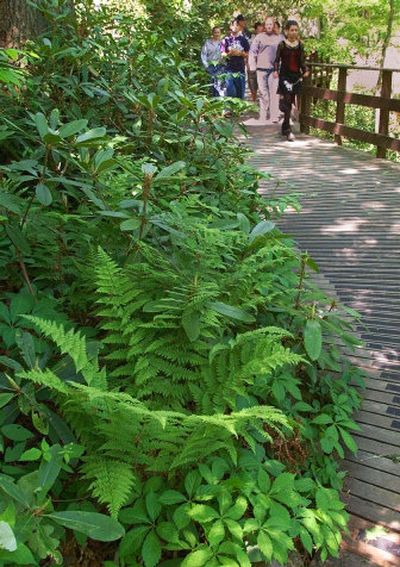Ferns fit in most landscapes

NEWPORT NEWS, Va. – Ferns have found a steadfast friend in Jim Orband. He believes their soothing looks and easy personalities deserve all the respect and use they can get in any kind of garden – big or small, country or city, formal or informal.
“So many people don’t include ferns in their landscape, and they’re really missing out on some nice plants,” says Orband, Virginia Cooperative Extension’s horticulture agent in York County, Va.
He also practices what he preaches in his small but densely planted garden in Yorktown, Va. There, more than 20 types of ferns are tucked among large shrubs such as hydrangea, nandina, fatsia and mahonia. Some of his ferns are deciduous, annually dying back to the ground during winter and returning in spring. Others are always there, greening up the scenery after fall’s first frosts do damage.
Ferns have traditionally been sprinkled sparingly or massed as groups to cover bare spots under trees. Orband finds they look quite happy socializing with other perennials or in a staring role as a single focal point.
One of those special studs is Male fern, an evergreen type that grows about 4 feet wide and 3 feet tall. Its dark-green fronds measure about eight inches at the widest point.
“It can really make a statement in the garden, covering the size of a hydrangea,” he says.
There are environmental advantages to growing ferns, says Orband. First, deer dislike them. Second, insects and diseases are not major problems on the plants.
The extension agent finds it tough to name his favorite ferns, but Autumn fern ranks among the five he eventually lists.
The plant features broad, triangular fronds that emerge in a copper color and unfurl to pinkish green.
For an oddity, Orband likes the Ghost variety of Japanese painted fern. Its silvery-gray foliage grows upward two to three feet, illuminating a dark area in the garden.
For winter holidays, he favors jolly-green Christmas fern. Some say Christmas fern got its name because the little leaflets on the fronds resemble miniature stockings. But, even its life span corresponds to the season, he says.
“It goes from growing upright to laying down flat right after Christmas,” says Orband. “Ferns provide an excellent role in the garden because they require no pesticides or fertilizers, and different ferns provide seasonal interest.”